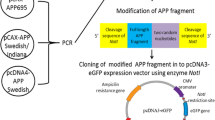Abstract
There are now various theories on the pathophysiology of Alzheimer’s disease (AD), the β-Amyloid (Aβ) cascade hypothesis has garnered a lot of interest. This text applied lentivirus-encapsulated plasmid to transfect APP695 (K595N, M596L) gene into SH-SY5Y cells and thereby obtain a stable cell line over-expressing Aβ. We used qPCR to monitor the mRNA expression of β-Amyloid Precursor Protein (APP) gene, β-Site APP Cleaving Enzyme 1 (BACE1) gene, we also used Western Blot to detect the APP protein, BACE1 protein, and Aβ1-42, respectively, in addition, the expression of Aβ1-42 in SH-SY5Y cell lysate and cell culture supernatant was measured by Enzyme-Linked Immunosorbent Assay (ELISA). The findings demonstrated APP gene over-expression following APP695 (K595N, M596L) gene transfection, and also indicated the successful establishment of the Swedish mutant cell model.




Similar content being viewed by others
REFERENCES
Cheignon, C., Tomas, M., Bonnefont-Rousselot, D., et al., Oxidative stress and the amyloid beta peptide in Alzheimer’s disease, Redox Biol., 2018, vol. 14, pp. 450–464. https://doi.org/10.1016/j.redox.2017.10.014
Cheng, Y., Tian, D.Y., and Wang, Y.J., Peripheral clearance of brain-derived Aβ in Alzheimer’s disease: pathophysiology and therapeutic perspectives, Transl. Neurodegener., 2020, vol. 9, рр. 1–11. https://doi.org/10.1186/s40035-020-00195-1
Conway, K.A., Baxter, E.W., Felsenstein, K.M., et al., Emerging β-amyloid therapies for the treatment of Alzheimer’s disease, Curr. Pharm. Des., 2003, vol. 9, pp. 427–447. https://doi.org/10.2174/1381612033391649
Dehury, B., Tang, N., and Kepp, K.P., Molecular dynamics of C99-bound γ-secretase reveal two binding modes with distinct compactness, stability, and active-site retention: implications for Aβ production, Biochem. J., 2019, vol. 476, pp. 1173–1189. https://doi.org/10.1042/bcj20190023
Haass, C., Kaether, C., Thinakaran, G., et al., Trafficking and proteolytic processing of APP, Cold Spring Harbor Perspect. Med., 2012, vol. 2, p. a006270. https://doi.org/10.1101/cshperspect.a006270
Hampel, H., Vassar, R., De Strooper, B., et al., The β‑secretase BACE1 in Alzheimer’s disease, Biol. Psychiatry, 2021, vol. 89, pp. 745–756. https://doi.org/10.1016/j.biopsych.2020.02.001
Knopman, D.S., Amieva, H., Petersen, R.C., et al., Alzheimer disease, Nat. Rev. Dis. Primers, 2021, vol. 7, p. 33. https://doi.org/10.1038/s41572-021-00269-y
Kovalevich, J. and Langford, D., Considerations for the use of SH-SY5Y neuroblastoma cells in neurobiology, Methods Mol. Biol., 2013, vol. 1078, pp. 9–21. https://doi.org/10.1007/978-1-62703-640-5_2
Liu, C.C., Kanekiyo, T., Xu, H., et al., Apolipoprotein E and Alzheimer disease: risk, mechanisms and therapy, Nat. Rev. Neurol., 2013, vol. 9, pp. 106–118. https://doi.org/10.1038/nrneurol.2012.263
Lovestone, S., Fleshing out the amyloid cascade hypothesis: the molecular biology of Alzheimer’s disease, Dialogues Clin. Neurosci., 2022, vol. 2, p. 2000. https://doi.org/10.31887/dcns.2000.2.2/slovestone
Stokin, G.B., Lillo, C., Falzone, T.L., et al., Axonopathy and transport deficits early in the pathogenesis of Alzheimer’s disease, Science, 2005, vol. 307, pp. 1282–1288. https://doi.org/10.1126/science.1105681
Tao, P., Zhao, Y., Song, X., et al., Preparation of the cells transfected with human APPswe695 gene and the determination of Aβ production, Chin. J. Cell Biol., 2019, vol. 41, pp. 72–79. http://dx.chinadoi.cn/10.11844/cjcb.2019.01.0008
Van Gool, B., Storck, S.E., Reekmans, S.M., et al., LRP1 has a predominant role in production over clearance of Aβ in a mouse model of Alzheimer’s disease, Mol. Neurobiol., 2019, vol. 56, pp. 7234–7245. https://doi.org/10.1007/s12035-019-1594-2
Vassar, R., Bennett, B.D., Babu-Khan, S., et al., β-Secretase cleavage of Alzheimer’s amyloid precursor protein by the transmembrane aspartic protease BACE, Science, 1999, vol. 286, pp. 735–741. https://doi.org/10.1126/science.286.5440.735
Wang, H., Xu, X.X., Pan, Y.C., et al., Recognition and removal of Amyloid-β by a heteromultivalent macrocyclic coassembly: A potential strategy for the treatment of Alzheimer’s Disease, Adv. Mater., 2021, vol. 33, p. 2006483. https://doi.org/10.1002/adma.202006483
Watamura, N., Sato, K., and Saido, T.C., Mouse models of Alzheimer’s disease for preclinical research, Neurochem. Int., 2022, vol. 158, p. 105361. https://doi.org/10.1538/expanim.22-0164
Wu, T., Lin, D., Cheng, Y., et al., Amyloid cascade hypothesis for the treatment of Alzheimer’s disease: progress and challenges, Aging Dis., 2022, vol. 13, pp. 1745–1758. https://doi.org/10.14336/AD.2022.0412
Yang, Y., Arseni, D, Zhang, W., et al., Cryo-EM structures of amyloid-β42 filaments from human brains, Science, 2022, vol. 375, pp. 167–172. https://doi.org/10.1016/j.cclet.2022.06.046
Yiannopoulou, K.G. and Papageorgiou, S.G., Current and future treatments in Alzheimer disease: An update, J. Cent. Nerv. Syst. Dis., 2020, vol. 12, pp. 1–12. https://doi.org/10.1177/1179573520907397
Zhao, J., Wang, M., Liu, W., et al., Activation of cannabinoid receptor 2 protects rat hippocampal neurons against Aβ-induced neuronal toxicity, Neurosci. Lett., 2020, vol. 735, p. 135207. https://doi.org/10.1016/j.neulet.2020.135207
ACKNOWLEDGMENTS
The authors thank the Analytical & Testing Center of Shenzhen Institute of Advanced Technology, CAS.
Funding
This research was supported by the National Natural Science Foundation of China (62074155, 62175252), the Basic and Applied Basic Research Foundation of Guangdong Province (2020A1515110142), the Shenzhen Overseas Innovation Team Project (no. KQTD20180413181834876), the Shenzhen Science and Technology Innovation Commission (KCXFZ202002011008124, JCYJ20210324101405016), and the SIAT Innovation Program for Excellent Young Researchers (E25402), the Natural Science Foundation of Ningxia (2020AAC03151), the Innovation and Entrepreneurship Training Program for College Students of Ningxia in 2020 (S202010752048).
Author information
Authors and Affiliations
Contributions
Conceptualization: J. D., Y. Z. and H. Y.; Methodology: H. Z., R. H., J. D.; Formal analysis and investigation: H. Z., Z. Y., R. H., S. H.; Writing—original draft preparation: H. Z., J. R., S. W., H. S.; Writing—review and editing: J. D., Y. Z., H. Y., Y. H.; Funding acquisition: H. Y., P. Z.; Supervision: J. D., Y. Z. and H. Y.
Corresponding author
Ethics declarations
CONFLICT OF INTEREST
The authors declare that they have no conflicts of interest.
ETHICS APPROVAL AND CONSENT TO PARTICIPATE
This work does not contain any studies involving human and animal subjects.
Additional information
Publisher’s Note.
Pleiades Publishing remains neutral with regard to jurisdictional claims in published maps and institutional affiliations.
Rights and permissions
About this article
Cite this article
Huitao Zhang, Hao, R., Yu, Z. et al. Generation of Stable Cell Lines of APP695 (K595N, M596L) Gene Over-Expression via Lentiviral Over-Expression System. Biol Bull Russ Acad Sci 51, 30–36 (2024). https://doi.org/10.1134/S1062359023602586
Received:
Revised:
Accepted:
Published:
Issue Date:
DOI: https://doi.org/10.1134/S1062359023602586




